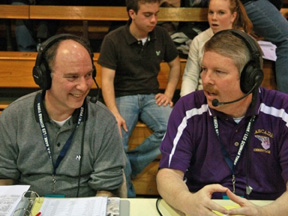A Prestigious Past: The Big Inch Club
Quill and Scroll Club Members Reflect
Before computers with spell check, cellphones, and the World Wide Web, there was the Big Inch Club. This Quill and Scroll club honored high school journalists who had written more than 10,000 column inches, an equivalent to writing 90 full pages of a daily newspaper.
In 1947, Ronald Dugger of Brackenridge High School in San Antonio, Texas, became the first member of the Big Inch Club. After his induction, more than 80 high school journalists became members of the Big Inch Club until it ended in 1984.
Richards Johns, who was the director of Quill and Scroll for 35 years beginning in 1972, said the Big Inch Club stopped because of a lack of entries.
“I think it needs to be re-promoted,” Johns said. “Basically, explaining what it is because I’m sure there are high school students across the country who could achieve that. Of course, today compared to then when it was primarily newspaper column inches they were counting, they could probably also include online materials as well.”
One member of the elite club is Greg Stiles. He was inducted in 1974, which was his junior year at Marshfield Senior High School in Coos Bay, Ore. Beginning in 8th grade, Stiles wrote for his school newspaper and the local daily, The World. Stiles said he worked nearly 30 hours a week for the papers, and he had written close to 10,501 inches at the time of his induction four years later.
“It was a milestone,” Stiles said of his Big Inch Club induction. “Because I was not, at that point, thinking about going into journalism, I didn’t take advantage of it. I know at least one college journalism department got a hold of me, and I pretty much said, ‘Thanks, but no thanks.’”
Yet, his journalistic experiences did not end in high school. Stiles received his master’s degree in journalism and public affairs from the American University in Washington, D.C., after majoring in history in college as an undergraduate and working for a year at the Mail Tribune, headquartered in Medford, Ore. Following graduate school, he returned to the Mail Tribune, where he was a sports writer for 20 years and a business writer for the past 10 years.
After so many years of being in the business, Stiles said he thinks a threat to journalism is the creation of a blogosphere with many opinions and not many researched stories. He also said the watchdog function of the press has weakened and many issues need to receive closer examination.
Stiles is concerned not many high school students work at the newspaper any more because the only way to become a better writer is to write as much as possible.
“The more you produce, the better you get,” Stiles said. “The idea is just to do it and rewrite and learn as you rewrite.”
Washington Post writer and Big Inch alumnus Tom Jackman agrees with this sentiment.
“I would tell them to write, write, and then write some more,” Jackman said as his advice for high school journalists. “Get published as often as you can. Be edited. Get feedback as often as you can. That’s what makes you better and that’s what any media outlet, not just print journalism, but TV, radio, Internet. They all want to see that you can write.”
Jackman grew up around journalists with two uncles working in the sports sections at newspapers. He attended Herndon High School in Virginia, where he wrote for The Stinger. By his junior year in 1977, Jackman was the news editor of the paper, and he became the editor-in-chief his senior year. In addition to his work on the school paper, Jackman wrote for two weekly newspapers. He wrote and took photos covering varsity sports for The Reston Times, and he also worked at The Herndon Observer.
“It got me energized and motivated to do it full time,” Jackman said. “I really enjoyed covering things, writing about them, seeing them published right away, getting feedback on the stories. I learned a lot about writing and being edited while covering things in high school, and that really helped spark my interest even more in becoming a professional journalist.”
Jackman attended Notre Dame University, where he majored in English and American Studies since the school did not have a journalism program. He worked on the student-run daily newspaper, which he called a great experience.
He then went to work at The New York Times as a clerk for two years. Clerks usually write stories on their own time and try to gradually work their way on to the staff.
“I worked on the foreign desk, which is really big,” Jackman said. “The competition was very heavy, and I was not good enough. I hadn’t had enough basic journalism training. I think it kind of hurt me that I didn’t go to journalism school, and then showed up at The New York Times.”
He then became a full-time reporter for 14 years at The Kansas City Times, where he covered general assignments for one year, police and crime for five years, and federal courts for eight years.
Jackman began working at The Washington Post in 1998. In 2002 and 2003, he covered the trial of one of the two snipers who terrorized the Washington, D.C. area. In 2007, he was the lead writer at The Washington Post covering the Virginia Tech shootings, for which he and his team won the Pulitzer Prize.
“I was a part of a team, so I was one of like 10 people who got it,” Jackman said of the Pulitzer. “It felt very cool, very awesome.”
Looking back to his days as a high school journalist, Jackman said he appreciated the experiences. He also was honored to be a member of the Big Inch Club.
“It’s not the greatest name in the world, but I was thrilled to win that award,” Jackman said. “And I was really happy about it.”


